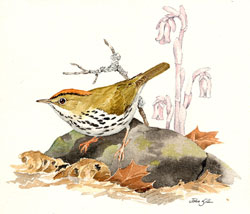Breeding Bird Atlases (BBA)
Find a Bird - BBA1
Breeding Bird Atlas 1 Species Accounts
Ovenbird
Seiurus aurocapillus
Egg Dates
May 17 to July 16
Number of Broods
one

The Ovenbird, a bird of mature deciduous and coniferous forests, is a common Massachusetts nester, a common spring migrant, and a regular though not abundant fall migrant. During the breeding season, it prefers open forests with little or no understory vegetation and ample leaf litter; during migration it can be found in woods, thickets, and scrubby habitats. Although undoubtedly scarce in sparsely wooded nineteenth-century Massachusetts, the Ovenbird is now a common nesting species throughout the forested regions of the state. It is a regular, though local resident of Cape Cod, Martha’s Vineyard, and the predominantly scrubby coastal regions. The explosive suburban development that has taken place in recent years has had an adverse effect on eastern breeding populations of Ovenbirds by removing and fragmenting their nesting habitat, which has resulted in disturbance and increased predation by dogs, cats, and natural enemies. Similarly, clear-cutting practices in Central American forests, where the Ovenbird is found during the winter, may adversely affect nonbreeding populations.
In spring, Ovenbirds begin to appear in late April, though the peak of spring migration does not occur until the second half of May. Males can be heard singing during early May, and territories of residents are well established by the middle of the month. The male’s territorial song, a loud teacher, teacher, teacher, increases in volume from the first to the last phrase and may be accented on either syllable (tea-cher or tea-cher). In forests lacking a dense understory, the song resonates quite a distance, thus making if difficult for the human observer to pinpoint the source. This song is given throughout June and into August but becomes much more intermittent after mid-July. Males also perform an aerial song display (often crepuscular or nocturnal) that has been variously described as a courtship display, sheer jubilation, or a territorial display. It can be heard well into August. Both sexes have several call notes, including a tchip contact note and a tick or tchuck of alarm.
During courtship, the male may strut before the female on the ground or chase her vigorously in flight. When the male has defined the territory, the female selects the nest site and builds the nest on the forest floor. The nest is a dome-shaped, Dutch-ovenlike construction made of dried leaves, twigs, and grasses, cryptically concealed by the abundant leaf litter. Two Pelham nests were made of dead leaves and dry White Pine needles (Nice 1931). Of 11 Massachusetts nests, 10 were located on the ground in deciduous or mixed forests (Nice 1931, CNR, Blodget). The remaining nest was built atypically among green grasses in an open space and was soon preyed upon. (Nice 1931, DKW, CNR). The eggs are incubated for 11 to 14 days by the female only. If an intruder approaches the nest too closely, an adult will perform a distraction display, fluttering across the forest floor with outspread wings and uttering loud ticks. These ticks are also voiced from low branches or shrubs.
The altricial young are helpless upon hatching. At 4 days of age their eyes are opening and the feather papillae are showing. By the sixth day, the feathers have broken through their sheaths, and the young become more active. They are well feathered at 8 days and are ready to fledge then or during the next 2 days. In Massachusetts, nestlings have been reported from June 2 to July 17 (Nice 1931, CNR, Blodget). Known hatch dates were June 12, June 13, July 10, July 16, and July 17 (Nice 1931, CNR). Brood size for 4 state nests was: two young (1 nest), three young (2 nests), four young (1 nest). Fledging dates for 2 nests were June 21 and July 17, respectively (Nice 1931, CNR).
The young are cared for by both adults for up to 10 days after fledging and receive some food until they are five weeks old. Food brought to the young consists of insects, spiders, slugs, centipedes, etc., picked up from the forest floor. Fledglings with adults have been reported in the state from June 21 to August 5 (Nice 1931, CNR, Meservey), but the actual range is probably greater. Data on second broods is lacking, but the range of dates for eggs and young suggests that the birds may renest after a failure.
In the juvenal plumage, the young differ from adults in being streaked or spotted with olive brown on the mantle, breast, and sides and having two conspicuous buffy wing bars. In the first winter plumage, acquired by a postjuvenal molt beginning in the end of June for the earliest fledged immatures, the young closely resemble the adults. The latter undergo a complete postnuptial molt during July, replacing wing and tail feathers as well as contour feathers. The young remain on the territory until after their molt. Adults may disperse before their molt is entirely complete; however, males can be heard singing territorial song well into August and may disperse later than their families.
The fall movement of Ovenbirds is less noticeable than that of spring. What little migration is observed begins in August and extends through September; stragglers are seen regularly during October, and occasional individuals survive into the early winter. The normal wintering grounds extend from the southern United States through Mexico and Central America to northern South America.
Map Legend and Data Summary
Atlas 1 data collected from 1975-1979


Note: common to very common in mixed and deciduous woodlands; possibly declining
Christina Dowd



